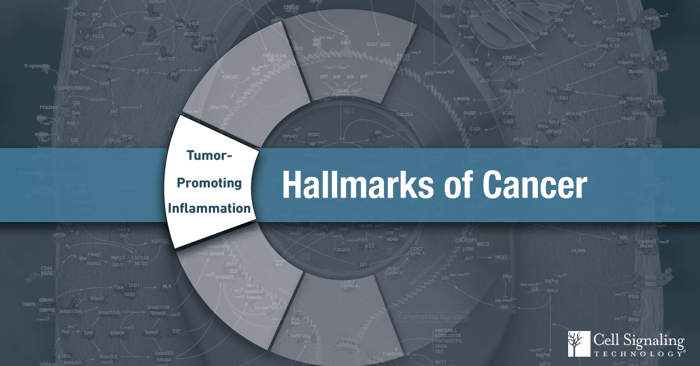Cancer cells hijack inflammatory mechanisms to promote their own growth and survival. During a normal inflammatory response by the innate and adaptive immune system, immune cells carry out their designated task of engulfing and/or destroying foreign invaders.

The Hallmarks of Cancer are seminal manuscripts by Doctors Robert Weinberg and Douglas Hanahan and were published in Cell. The authors proposed the idea that the complexity of cancer can be broken down into smaller subsets of underlying principles. The information here pertains to one Hallmark of Cancer, known as "Tumor-promoting Inflammation." Other entries in this series explore the other proposed Hallmarks.
Within the complex tumor microenvironment (TME), the same infection-fighting immune cells are corrupted by cancer cells. As a result, instead of destroying the transformed cells, the anti-tumor immune cells are subverted into tumor-promoting immune cells that secrete pro-survival, pro-migration, and anti-detection factors that allow tumor growth and metastasis. Important molecules and signaling pathways in mediating the immune response to the tumor microenvironment include NF-κB, inflammasome signaling, tumor-infiltrating immune cell markers, and immune checkpoint signaling.
NF-κB
In immune cells, NF-κB signaling regulates the transcription of genes, influencing innate and adaptive immunity, inflammation, stress responses, B-cell development, and cytokine/chemokine release. In unstimulated cells, NF-κB is in a complex with IκB inhibitory proteins in the cytoplasm. Upon activation, IκB proteins are phosphorylated, then targeted for rapid degradation through the ubiquitin-proteasome system. Removal of IκB proteins releases the sequestered NF-κB, allowing its entry into the nucleus where it can regulate gene expression.
NF-κB signaling in cancer and immune cells within the tumor microenvironment has been particularly implicated in the epithelial-to-mesenchymal transition (EMT) of cells on the tumor border, allowing the detachment and migration of the tumor mass. EMT is a classic hallmark of malignant cancers. Thus, the cross-talk between NF-κB signaling in immune-infiltrating cells and cancer cells establishes an environment that promotes tumor growth, invasion, and malignancy in cyclical feedforward manner.
Inflammasome Signaling
The innate immune system is the first line of defense in protection from pathogenic microbes and host-derived signals of cellular distress. One way in which these “danger” signals trigger inflammation is through the activation of inflammasomes, which are multiprotein complexes that assemble in the cytosol. The inflammasome promotes the cleavage of caspase-1 and subsequent cleavage of proinflammatory cytokines IL-1β and IL-18.
The best-characterized inflammasome complex is the NLRP3 complex, which contains NLRP3, ASC (an adaptor protein), and a number of other proteins.
Tumor-Infiltrating Markers
The immune system can identify and eliminate cancer cells through both innate and adaptive mechanisms; however, such antitumor responses can be inhibited by the microenvironment through a process known as immunosuppression. Cancer immunotherapy aims to manipulate both immunosuppressive and immunostimulatory mechanisms to increase the anticancer immune response. Therefore, it is important to understand tumor-infiltrating immune cells and their role in tumor growth and suppression.
Tumor-infiltrating immune cells are derived from either a myeloid or lymphoid cell lineage. The abundance and subtype of immune cells within a tumor microenvironment correlate with prognosis. In addition, careful analysis of these two origins can lead to the development of suitable immunotherapeutic strategies for patients.
Once a tumor is established, it can circumvent immune detection through various mechanisms, including antigen loss, down-regulation of major histocompatibility molecules, alteration of the endogenous antigen presentation pathways, and immune suppression via cytokine secretion. Along with their ability to evade detection by the immune system, tumors can also hijack immune cells to promote self-growth and metastasis. Immune suppression and subversion by a tumor generally occur in a step-wise manner.
Immune Checkpoints
Immune checkpoints refer to the built-in control mechanisms of the immune system that maintain self-tolerance and help to avoid collateral damage during a physiological immune response. Research has shown that tumors engineer microenvironments to evade immune surveillance and attack, particularly by modulating certain immune checkpoint pathways.3
Because T cells are the primary effector immune cells, they express multiple autoinhibitory cell surface receptors, such as
, that modulate their response. Within the tumor microenvironment, tumor cells can upregulate the ligands to these receptors to enhance tumor tolerance and evade eradication by the immune system.
In recent years, pharmacological modulators of these ligand-receptor interactions, known as immune checkpoint therapies, have been intensely researched and deployed as novel immunotherapy agents to treat cancers. Of particular interest are monoclonal antibodies against PD-1 and CTLA-4. Given the early success of these immune checkpoint therapies in activating anti-tumor immune responses, creating immunotherapies targeting other co-inhibitory and co-stimulatory receptors and their ligands in order appears to be a compelling therapeutic strategy.









/42157_chimeric%20antibody%20blog%20featured3.webp)


